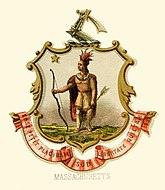Great Seal of Massachusetts
| Great Seal of the Commonwealth of Massachusetts | |
|---|---|
 |
|
| Versions | |
 |
|
| Details | |
| Armiger | Commonwealth of Massachusetts |
| Adopted | December 13, 1780 |
| Motto | Ense petit placidam sub libertate quietem |
| Coat of Arms of the Commonwealth of Massachusetts | |
|---|---|
 |
|
| Versions | |

The simplified coat of arms used in the state flag and larger signage
|
|

Historical coat of arms (1876)
|
|
| Details | |
| Armiger | Commonwealth of Massachusetts |
| Adopted | 1775 |
| Motto | Ense petit placidam sub libertate quietem |
The Great Seal of the Commonwealth of Massachusetts contains the coat of arms of Massachusetts. The coat of arms is encircled by the Latin text "Sigillum Reipublicæ Massachusettensis" (literally, The Seal of the Republic of Massachusetts). The Massachusetts Constitution designates the form of government a "commonwealth," for which Respublica is the correct Latin term. The Seal uses as its central element the Coat of Arms of Massachusetts. An official emblem of the State, the Coat of Arms was adopted by the Legislature in 1775, and then reaffirmed by Governor John Hancock and his Council on December 13, 1780. The present rendition of the seal was drawn by resident-artist Edmund H. Garrett, and was adopted by the state in 1900. While the inscription around the seal is officially in Latin, a variant with "Commonwealth of Massachusetts" in English is also some times used.
The seal was adopted by the Provincial Congress on December 13, 1780. The shield depicts an Algonquian Native American with bow and arrow; the arrow is pointed downward, signifying peace. A white star with five points appears next to the figure's head. A blue ribbon (blue, signifying the Blue Hills of Quincy, Canton and Milton) surrounds the shield, bearing the state motto "Ense petit placidam sub libertate quietem" This comes from the Book of Mottoes in the Royal Danish Library in Copenhagen, Denmark; written about 1659 by Algernon Sydney, English soldier and politician. It was adopted in 1775 by the Provincial Congress and the literal translation is, "With a sword, she seeks quiet peace under liberty." Although the looser English translation more commonly used is, "By the sword we seek peace, but peace only under liberty." Above the shield is the state military crest: a bent arm holding a broadsword aloft. The sword has its blade up, to remind that it was through the American Revolution that independence was won.
...
Wikipedia
